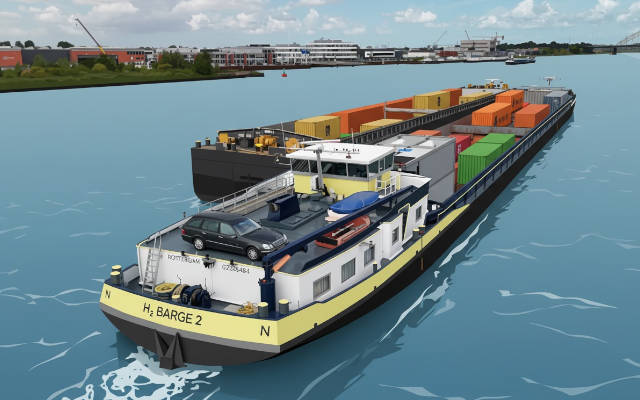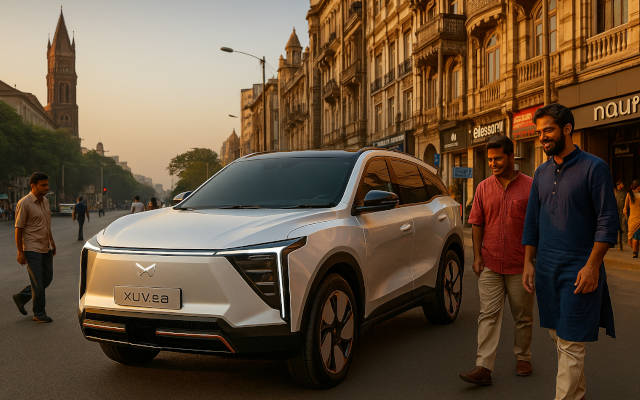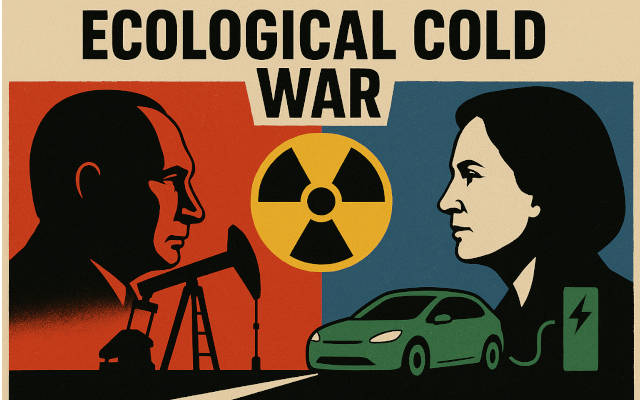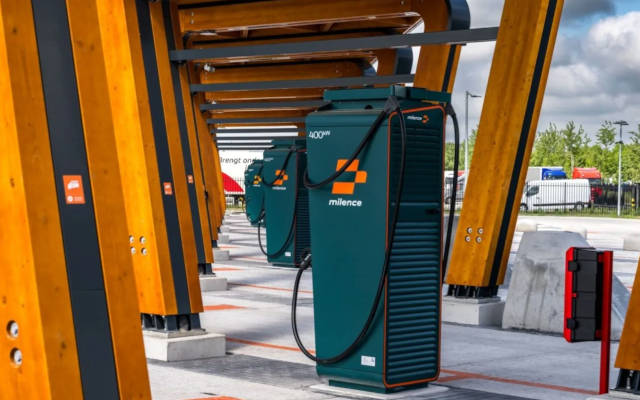 EDITOR'S PICK
EDITOR'S PICK
Hydrogen Sets Sail for Zero-Emission Shipping in the Netherlands
01 Sep 2025 | Synopsis
 Hydrogen-powered inland vessels have begun operating in the Netherlands, notably the H2 Barge 2 retrofitted with fuel-cell and electric propulsion. Operating between Rotterdam and inland terminals, it completes ~100 round trips yearly, cutting about 2,000 tonnes of CO₂ per year. Funded under the EU's Zero Emission Ports North Sea (ZEM Ports) project, the initiative highlights hydrogen's promise for clean maritime transport - but widespread adoption still faces cost and incentive obstacles.
Hydrogen-powered inland vessels have begun operating in the Netherlands, notably the H2 Barge 2 retrofitted with fuel-cell and electric propulsion. Operating between Rotterdam and inland terminals, it completes ~100 round trips yearly, cutting about 2,000 tonnes of CO₂ per year. Funded under the EU's Zero Emission Ports North Sea (ZEM Ports) project, the initiative highlights hydrogen's promise for clean maritime transport - but widespread adoption still faces cost and incentive obstacles.India is Building a Strong EV Ecosystem While the World Only Sees Tesla & BYD
01 Sep 2025 | Synopsis
 India's EV sector is rapidly evolving beyond headline makers like Tesla and BYD, developing a homegrown ecosystem. Local startups and incumbents are advancing battery tech, charging networks, and deep-tech innovation. Government support -including FAME II, PLI schemes, and customs exemptions - is boosting domestic manufacturing, startups, and infrastructure. While global attention lingers on foreign brands, India's EV ecosystem is quietly maturing with scale and resilience.
India's EV sector is rapidly evolving beyond headline makers like Tesla and BYD, developing a homegrown ecosystem. Local startups and incumbents are advancing battery tech, charging networks, and deep-tech innovation. Government support -including FAME II, PLI schemes, and customs exemptions - is boosting domestic manufacturing, startups, and infrastructure. While global attention lingers on foreign brands, India's EV ecosystem is quietly maturing with scale and resilience.The Coming Ecological Cold War
01 Sep 2025 | Synopsis
 The energy transition is more than tech or economics—it’s reshaping geopolitics. IEA's "Net Zero by 2050" imposes an all-out electrification, doubling electricity, zero-carbon, renewables, EV share leaps, industrial & building overhaul by 2050. This sparks an eco-ideological Cold War: a Sino-European green entente vs an axis of petrostates (U.S., Russia, Saudi Arabia) resisting decarbonization
The energy transition is more than tech or economics—it’s reshaping geopolitics. IEA's "Net Zero by 2050" imposes an all-out electrification, doubling electricity, zero-carbon, renewables, EV share leaps, industrial & building overhaul by 2050. This sparks an eco-ideological Cold War: a Sino-European green entente vs an axis of petrostates (U.S., Russia, Saudi Arabia) resisting decarbonizationThe Dutch Blueprint: Infrastructure Supercharges EV Adoption
01 Sep 2025 | Synopsis
 The Netherlands leans on its robust EV charging infrastructure rather than incentives alone: with 10.04 charge points per 1,000 people and over 157,000 outlets, it's Europe's densest network - even as the country ranks fourth in EV market share (~35%). Policymakers banned fossil-fuel vehicle sales by 2030 and are phasing down subsidies. Challenges now include rising charging costs - up 13% overall and 25% in Amsterdam.
The Netherlands leans on its robust EV charging infrastructure rather than incentives alone: with 10.04 charge points per 1,000 people and over 157,000 outlets, it's Europe's densest network - even as the country ranks fourth in EV market share (~35%). Policymakers banned fossil-fuel vehicle sales by 2030 and are phasing down subsidies. Challenges now include rising charging costs - up 13% overall and 25% in Amsterdam.Charlie Munger's BYD Bet: Berkshire's Billion-Dollar EV Play
30 Aug 2025 | Synopsis
 Charlie Munger led Berkshire Hathaway to invest $230M in BYD in 2008, recognizing its potential in batteries and EVs. Displayed at the Omaha shareholder meeting, BYD grew into a global EV leader. Berkshire's stake peaked near $9.5B, with over $7B in profit from sales. Now holding under 5%, Berkshire's move reflects Munger's long-term vision and BYD's rise as a vertically integrated powerhouse in electric mobility.
Charlie Munger led Berkshire Hathaway to invest $230M in BYD in 2008, recognizing its potential in batteries and EVs. Displayed at the Omaha shareholder meeting, BYD grew into a global EV leader. Berkshire's stake peaked near $9.5B, with over $7B in profit from sales. Now holding under 5%, Berkshire's move reflects Munger's long-term vision and BYD's rise as a vertically integrated powerhouse in electric mobility.
 EVWorld Exclusive
EVWorld Exclusive
Creative Destruction vs. Fossil Retrenchment: Why Project 2025 Risks Leaving America Behind
16 Oct 2025 |  Project 2025 protects fossil fuel incumbents by dismantling Biden-era clean energy policies. Nobel economist Philippe Aghion argues that climate progress depends on creative destruction - letting green innovators outcompete legacy polluters. The U.S. risks falling behind as global markets embrace clean tech. Even its passport has slipped from the top 10. Innovation, not retrenchment, is the path forward
Project 2025 protects fossil fuel incumbents by dismantling Biden-era clean energy policies. Nobel economist Philippe Aghion argues that climate progress depends on creative destruction - letting green innovators outcompete legacy polluters. The U.S. risks falling behind as global markets embrace clean tech. Even its passport has slipped from the top 10. Innovation, not retrenchment, is the path forward
Buick Electra E5: China-Built EV Poised for U.S. Launch
16 Oct 2025 |  Buick's Electra E5, built in China by SAIC-GM, is set to become GM's first imported EV for the U.S. market. Though its launch was delayed indefinitely in 2024, a tentative 2026 rollout remains part of GM's electrification roadmap. With Ultium battery tech, strong performance specs, and positive reception in China, the Electra E5 represents a strategic shift in global EV sourcing and branding.
Buick's Electra E5, built in China by SAIC-GM, is set to become GM's first imported EV for the U.S. market. Though its launch was delayed indefinitely in 2024, a tentative 2026 rollout remains part of GM's electrification roadmap. With Ultium battery tech, strong performance specs, and positive reception in China, the Electra E5 represents a strategic shift in global EV sourcing and branding.
China's EV Boom Masks a Hidden Inventory Problem
15 Oct 2025 |  China's EV market shows strong wholesale growth, but retail sales lag behind. In April 2025, the wholesale-retail ratio hit 1.27:1, signaling inventory buildup. Automakers push stock to dealers to meet targets, risking oversupply. Analysts warn this gap could lead to price wars and financial strain. Retail data offers a clearer view of consumer demand and market health.
China's EV market shows strong wholesale growth, but retail sales lag behind. In April 2025, the wholesale-retail ratio hit 1.27:1, signaling inventory buildup. Automakers push stock to dealers to meet targets, risking oversupply. Analysts warn this gap could lead to price wars and financial strain. Retail data offers a clearer view of consumer demand and market health.
Putting Children First: Lessons from Paris for Atlanta
15 Oct 2025 |  Paris redesigned its streets with children in mind - wider sidewalks, less traffic, and safer zones near schools. This child-first approach improved mobility for all, including seniors and cyclists. Atlanta can learn from Paris by investing in protected bike lanes, rethinking zoning, and prioritizing equity. A city where children thrive is safer, healthier, and more connected. The shift is not just practical - it's a moral imperative.
Paris redesigned its streets with children in mind - wider sidewalks, less traffic, and safer zones near schools. This child-first approach improved mobility for all, including seniors and cyclists. Atlanta can learn from Paris by investing in protected bike lanes, rethinking zoning, and prioritizing equity. A city where children thrive is safer, healthier, and more connected. The shift is not just practical - it's a moral imperative.
Micromobility's Insurance Gap: What Riders Need to Know
15 Oct 2025 |  Micromobility use is surging, but insurance coverage lags. Most auto and home policies exclude e-bikes and scooters, leaving riders exposed. Accidents are rising, and shared services often don't cover users. InsurTech firms offer on-demand solutions, but adoption is low. Riders should check existing coverage, consider standalone policies, and push for clearer regulations to close the gap and ensure safe, sustainable urban transport.
Micromobility use is surging, but insurance coverage lags. Most auto and home policies exclude e-bikes and scooters, leaving riders exposed. Accidents are rising, and shared services often don't cover users. InsurTech firms offer on-demand solutions, but adoption is low. Riders should check existing coverage, consider standalone policies, and push for clearer regulations to close the gap and ensure safe, sustainable urban transport.
SEARCH RSSTREAM
 49 New Postings In Past 24 Hours
49 New Postings In Past 24 Hours
Category:energy
Region:Global
Date:16 Oct 2025
Category:mobility
Region:NoAmerica
Date:16 Oct 2025
Category:policy
Region:Global
Date:16 Oct 2025
Category:mobility
Region:AsiaPacific
Date:16 Oct 2025
Category:mobility
Region:NoAmerica
Date:16 Oct 2025
Category:policy
Region:NoAmerica
Date:16 Oct 2025
Category:policy
Region:NoAmerica
Date:16 Oct 2025
Category:energy
Region:NoAmerica
Date:16 Oct 2025
Category:energy
Region:Europe
Date:16 Oct 2025
Category:energy
Region:AsiaPacific
Date:16 Oct 2025
Category:mobility
Region:Europe
Date:16 Oct 2025
Category:mobility
Region:AsiaPacific
Date:16 Oct 2025
Category:energy
Region:Europe
Date:16 Oct 2025
Category:policy
Region:Europe
Date:16 Oct 2025
Category:mobility
Region:NoAmerica
Date:16 Oct 2025
Category:mobility
Region:Europe
Date:16 Oct 2025
Category:finance
Region:NoAmerica
Date:16 Oct 2025
Category:mobility
Region:AsiaPacific
Date:16 Oct 2025
Category:mobility
Region:NoAmerica
Date:16 Oct 2025
Category:policy
Region:Global
Date:16 Oct 2025
